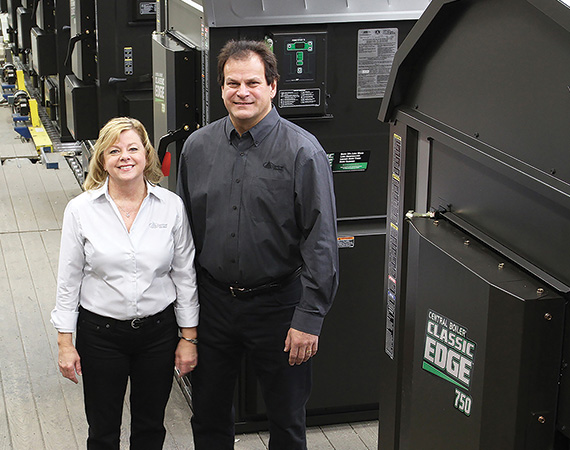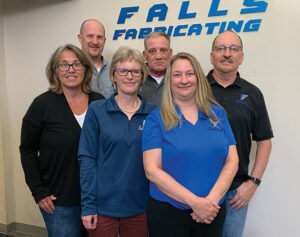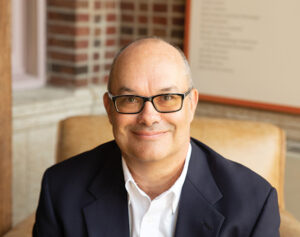In the mid-1980s, in the northwest corner of Minnesota — an area better known for snowmobiles than lawn mowers — a farm kid named Dennis Brazier decided to build a better wood-burning furnace. He kept at it until he had a company that owns over half the market and has sold a quarter of a million furnaces across the U.S., Canada and internationally. Central Boiler started out in a small farm shop just south of Greenbush, Minn., in Roseau County in 1984. Today it consists of three companies that produce top-line outdoor Central Boiler and WoodMaster furnaces and Altoz lawn mowers, employs 240 people in two manufacturing facilities, and is North America’s largest manufacturer of outdoor furnaces.
Brazier grew up on a farm near Greenbush, a dot on the map between Thief River Falls and the Canadian border. Like most farmers’ sons, he developed good work habits, a generalist’s range of knowledge, creative problem solving skills, and a love of motors and wheels.
While still in high school, Brazier bought his own seed and fertilizer, worked 18 acres with his dad’s 1950s-era farm equipment, and used the profits for spending money. He expanded his farming operation after graduating, but he had his sights on other things. He bought, repaired, and sold cars and farm machinery on the side. Two summers of bridge building taught him additional life skills and leadership lessons that he applied to Central Boiler.
By the time he married Terri in 1985, he had already built his first wood furnace. “Outdoor furnaces had been around a while,” Brazier says. “I had seen little buildings with smoke coming out but hadn’t paid much attention.” Then his brother-in-law bought one — some assembly required — which Brazier described as “a crazy contraption, a pile of black metal.” Meanwhile, Brazier’s parents, who still lived on the farm, had welded together their own outdoor furnace. “It was terrible — not efficient,” Brazier says. “I thought, this is ridiculous. I know I can do something better.”
In 1984, Brazier’s first furnace resembled an overgrown barrel stove, but he discarded it as having too many flaws. That first design, however, was the birth of Central Boiler. With further experimentation and working with his brother-in-law, he designed, built, and sold his first outdoor wood furnace with a square firebox in 1985.
Outdoor wood-burning furnaces: A safer, better, wood-heat option
Outdoor wood-burning furnaces — usually located 30 to 200 feet away from the house — present a safer, cleaner option to indoor wood-burners. They eliminate smoke, carbon monoxide dangers, and chimney fires. But early units on the market were inefficient and inconvenient. Within a few years, Brazier had found ways to improve on virtually every aspect of earlier designs. His furnaces were better constructed, easier to install and maintain, safer, cleaner, and more energy efficient. As fuel prices fluctuated, the market for better outdoor wood-burning furnaces grew, especially where wood — much of which could be harvested by the users — was readily available.
Evolution of the facility: Central Boiler continues to outgrow its space
Brazier designed his earlier furnaces on his kitchen floor and in an 18’ x 50’ shop on the farm. With money earned from farming and the help of family and friends, he built a 54’ x 104’ workshop in 1986. By 1988, Central Boiler offered the Classic CL-17 and CL-40, their first outdoor wood furnaces with all-weather steel siding. What had started as a side business that peddled just a few furnaces a year quickly grew into a full-fledged manufacturer — one that broke its own sales records year after year. Brazier further developed the company by buying equipment and materials as he could afford them. He took out a small loan once the company was started, but interest rates in the volatile ’80s ran in the two-digit range. He didn’t spend money he didn’t have. “I borrowed my father-in-law’s welder for two years before I bought my own,” he says.
Terri worked at the post office and took over bookkeeping for the company. “We have the same money management views and complementary skills,” Brazier says. “She is super meticulous.” As Central Boiler grew, Dennis built, sold and delivered furnaces and parts himself. “The business grew big fast,” he says, “and Terri started getting things organized.” She handled invoicing and accounts receivable for several years, with the accuracy her husband describes as “down to the exact penny with everything detailed.”
“We’ve been an excellent team,” says Terri, now corporate officer/owner. “Dennis is the head; I’m the heart. He’s always had an engineering spirit. He does the product development; I work with the people and the things that make Central Boiler a good place to work.”
The company grows, product continues to improve
In 1989, Central Boiler sold over a hundred furnaces and introduced the CL-75, nicknamed the “jumbo furnace.” Over the next few years, sales tripled and semi-loads of furnaces were shipped out to meet the orders of more than 40 dealers across the country. In 1991, Central Boiler sold over 700 furnaces and had outgrown its workspace.
Brazier built a new 24,000-square-foot facility at its current location, adjacent to the family farm. The facility included offices and research and development space. With room to grow, the company built over 1,600 furnaces in 1992, and added 25,000 square feet of manufacturing space the next year. Further additions to the shop occurred in 1993, 2000, 2001, 2006 and 2011. Today’s facility houses assembly lines for both outdoor furnaces and Altoz lawn mowers in a 300,000-square-foot plant.
Demand grew steadily through the early 2000s; Central Boiler added a second production shift and set up a dealer e-commerce website for online ordering. In 2004, an unprecedented 1,000 furnaces were shipped out in a single month — a record broken the very next year when 1,000 furnaces were ordered in a single week. That year, 2005, Central Boiler hired close to 50 new workers, dealers increased by one-third, and Central Boiler produced 10,000 furnaces.
Central Boiler furnaces go green
Improvements continued. Brazier developed new products and models for wood pellets and corn, more efficient and leaner manufacturing processes, plant expansions and upgrades.
Initially, customers purchased Central Boiler furnaces because they were well-built, economical and easy to install and use. Today’s consumers are also concerned about the environmental impact, and Central Boiler has covered that base as well.
In 1995, Central Boiler participated in an Environmental Protection Agency (EPA) project that evaluated its Classic furnace for efficiency and emissions. The Classic performed the best of all wood furnaces tested. Early in 2007, the company partnered with the EPA “to promote the manufacture and sale of cleaner outdoor wood furnaces.” That year, the Central Boiler E-Classic 2300 became the first outdoor wood furnace to receive a qualifying label from the EPA’s Outdoor Wood-fired Hydronic Heaters program.
In 2008, the state of Vermont’s Control Division certified that the Central Boiler E-Classic 2300 met their emissions standards — the first outdoor furnace to do so — and became the only such product allowed to be sold in Vermont at the time.
As the company moved toward additional eco-friendly furnaces, they also made them more user friendly. The Classic Edge FireStar Combustion Controller makes burning wood almost fool proof by monitoring how the wood is burning and adjusting the air intake for maximum efficiency, ensuring longer burning times and consuming 60% less wood. Text or email notifications alert the owner about when more wood needs to be added. Today, Central Boiler’s central heater furnaces hold the top three rankings in the country for low emissions and high efficiency in a field of about 250 heaters. The EPA certifies Central Boiler’s Classic Edge Titanium HDX outdoor wood furnaces at 90% efficiency, and consumers can claim a 26% federal tax credit on qualified Central Boiler models and installation.
Ease of installation, loading and maintenance have contributed to Central Boiler’s top rankings. The company’s 10-year warranty on its outdoor furnaces (1998) was more than one-upped in 2002 with an impressive 25-year warranty. Central Boiler has over 400 dealers throughout the U.S. and Canada. Their furnaces are certified under European test standards and are sold in Norway, Sweden, Germany, Austria, Ireland, the U.K. and Russia.
Production and Central Boiler’s growth
Most of the cutting, bending, welding, washing, painting and assembling of Central Boiler furnaces is done on site, allowing more control over the quality of work. The company buys welded steel fire boxes from a number of suppliers, but all fire boxes undergo stringent inspection and testing before they can become part of a Central Boiler furnace.
The company purchased its first laser cutter in the mid-1990s and has added six more since then. In 1996, Brazier added his first turret punch and press brake, and in 2009, added a state-of-the-art robot to perform some of the heavy repetitive work in order to reduce physical demands on employees. The assembly line raises or lowers the boilers as needed so that workers don’t have to strain to work or lift above the shoulders or below the knees.
In 2010, Central Boiler manufactured its 1,000th Maxim wood-pellet furnace and launched the E-Classic 2400, which won the Vesta Award at the Hearth, Patio & Barbecue Expo. That same year, Brazier was inducted into the IDEA Competition Partner’s Hall of Fame, honoring him for over 25 years of innovation.
From outdoor wood furnaces to zero-turn mowers
In 2010, the company also announced its newest venture: production of zero-turn Altoz mowers. In 2011, a 46,000-square-foot addition was built to accommodate increased manufacturing, and the company started producing Altoz. For Brazier, manufacturing lawn mowers seemed a perfect diversification. “Altoz mowers were for the summer season,” he says, “so they complemented the Central Boiler furnaces. To diversify, we wanted something out of the heating business. I like machinery, love mowing lawn — it seemed natural to me.” And although northerners think of mowing as a summer task, there are lawns to be mowed around the country (and in other countries) all year long.
An early attempt at building his own lawn mower had resulted in a functional but Frankenstein-ish machine; but after three decades of designing and manufacturing experience, Brazier was ready to produce a better mower. Zero radius turn machines had been around for a while, but as Altoz’s brochure says, the machine was “purpose-built to work longer and cover more ground” than its competition, especially in areas with hills, slants, moist soils or delicate obstacles like orchards, vineyards and solar fields.
Production of the Altoz filled winter months when outdoor furnace production slowed. After a decade of production, demand for Altoz continues to grow in stride with its reputation for powerful performance, reduction of trenching or rutting, and simplicity to use. Maneuverability, particularly around obstacles or making sharp turns, ranks high for the Altoz.
With models that offer up to 37 hp, speeds of 8-12 mph, and cutting widths up to 72”, the Altoz boasts agility, stability and comfort for getting big jobs done quickly and precisely. Earlier this year, Altoz introduced its first tracked stand-on mower, the Altoz TSX. Primarily for commercial use and lawn care professionals, it is billed as “the first of its kind in the world.”
“Most [Altoz mowers] go east of the Mississippi,” says Karl Bjorkman, Altoz sales and marketing director. “We’ll move west as we continue to expand. Many are sold for commercial use on places where other mowers can’t go — solar fields, water retention ponds, etc. These are niche markets for the Altoz, especially for the newly released track models.” Altoz ride-on or stand-on track machines, both industry firsts, “can replace guys with string trimmers” cutting grass in areas that are inaccessible for most mowers.
Central Boiler’s third company
Central Boiler’s most recent venture was the acquisition of WoodMaster, another outdoor wood furnace manufacturer, located in Red Lake Falls just 60 miles south of Greenbush.
“WoodMaster was our biggest competitor,” Brazier says. “We joined forces with them. Most of the family that owned it still work there. The advantage we bring is our organizational umbrella.”
Central Boiler has moved some of its production to Red Lake Falls, expanding their operation and creating jobs in the community of about 1,400.
In spite of the pandemic, Brazier says 2020 was a good year for both furnaces and lawn mowers. People didn’t travel but spent more time outdoors and at home. With the trend toward self-sufficiency, chopping and burning wood became more popular. Sales manager Bjorkman notes, “My woodpile has never been so high.”
The success comes from its employees
Both Dennis and Terri Brazier attribute Central Boiler’s success to the people who work there. Most employees live within 20-30 miles of Greenbush (population about 700). Many grew up together, went to school together; they know each other’s families, and the workplace is an extended family.
Central Boiler has a balance of long-term and recent employees. Jarod Reierson, human resources manager for Central Boiler, says 41% of the company’s workforce has been with the company for over 10 years, and 31% of the workforce has been hired since July 1, 2020.
Originally from Thief River Falls, Reierson was recruited to join Central Boiler at a college career fair. Now he’s hiring people — some of them through job fairs — in careers from engineering and manufacturing to IT, network systems, website management, marketing, shipping and receiving, and more. Central Boiler employs machine shop programmers and operators, welders, and has its own videographer, graphic designers, and technical writers who produce the company’s brochures and other publications.
“We have 16 youth who are employed for the summer — recent high school graduates and college students,” Reierson says. They work in assembly, shipping, office work and IT. Some have earned internships; some will go on for training in any one of several areas needed at Central Boiler and, hopefully, return.
Central Boiler offers incentives, like a $2,500 hiring bonus for new full-time employees and a $1,000 completion bonus for high school and college students who work at least 400 hours during the summer. “These have been very successful incentives,” Reierson says.
Terri Brazier describes the Central Boiler crew as “a well-honed team” and adds: “We work from the philosophy of treating people as you would want to be treated and respecting each person’s personhood.” The company holds health fairs and wellness programs. They celebrate length of service, hold company picnics, and host a bonus party at the end of the year with fun themes like “Red Neck” or “The 1980s.”
In June 2021, Central Boiler was named by the Star Tribune as one of the Top 175 Work Places in Minnesota, ranking 29th of 60 mid-sized companies. The recognition is employee initiated and based on employee surveys by Energage. Central Boiler employees listed several benefits ranging from the company’s commitment to its employees’ health and safety to profit sharing bonuses and a 401(k) match.
Central Boiler employees work with the safety director to design and implement safety practices, and the company has been a MNSHARP workplace for the past several years, going above and beyond OSHA standards. A sign posted in the plant boasts: “Over 20 years (7,333 days), we are proud to have had only two lost time injuries.”
…
Featured story in the Fall 2021 issue of Enterprise Minnesota magazine.


